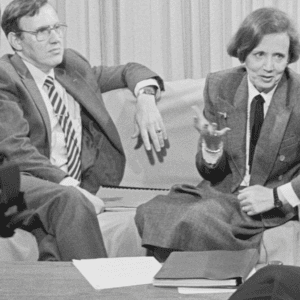This module is part of the #AHRSyllabus project. More information about the project can be found on the AHR website under #AHRSyllabus.

Taping of the testimony of Stephen H. and Marion L. in 1985. Photo courtesy of Fortunoff Video Archive.
Agnieszka Aya Marczyk, Abby Reisman, Brenda Santos
This module introduces a new curricular and instructional model, Historiography-Based Inquiry, or HBI, that allows students to see the processes through which historians make claims and marshal evidence to support them. A framing essay outlines the HBI’s structure and design principles, highlighting the challenges and opportunities involved in translating the work of historical interpretation for students. Following the framing essay, the HBI team provides a complete unit of instruction that engages students in a historiographical investigation of the role survivor testimony and voices of victims play in writing the history of the Holocaust. The unit provides teachers with a historiographical map of debates over the use of Holocaust testimony; a document packet that focuses on the place of testimony in the work of three leading historians of the Holocaust; and links to primary sources that will enable students to directly engage with some of the key sources that have driven major interpretative approaches to Holocaust history.
Read the module in full here.


